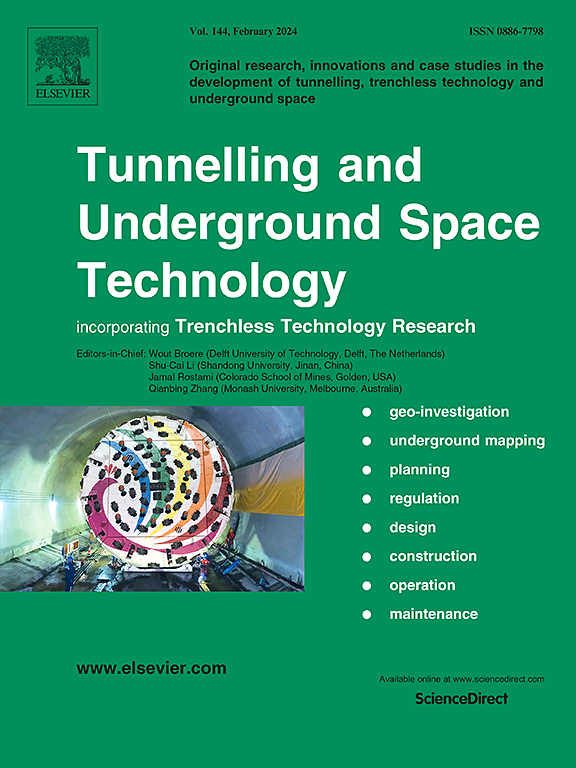基于浆体盾构机运行数据学习的土机交互作用研究:一种地质条件识别模型
IF 7.4
1区 工程技术
Q1 CONSTRUCTION & BUILDING TECHNOLOGY
引用次数: 0
摘要
在水下盾构隧道施工中,地质条件的实时感知对高效掘进和防灾具有重要意义。针对目前软土盾构隧道地质条件识别研究中存在开挖数据利用不足、模型缺乏优化、预测精度和效率低等问题,提出了一种地质条件-盾构机相互反馈感知方法。首先,建立浆体盾构机掘进参数数据库,其中包含6个与运行参数相关的输入特征,其中包含国内某跨江盾构隧道269个掘进周期;然后,采用离群点检测方法对数据样本集进行预处理,去除离群点。在此基础上,利用遗传算法对K-means聚类算法进行优化,实现地质条件类的聚类。得到了聚类性能较好的4个类别。为了获得预测性能最好的地质条件类别识别模型,利用75%的样本数据进行数据学习,并通过10次交叉验证确定各模型的最优训练参数。剩下的25%的数据用于验证四个分类器的性能。采用四个统计指标,即accuracy、F1评分、Precision和Recall来评估所提出模型的准确性水平。试验结果表明,在3种识别模型中,PSO-ELM算法能较好地表征和预测盾构掘进的地质条件。最后,采用合成少数派过采样技术(SMOTE)对数据库进行处理,消除类别不平衡对识别性能的影响,获得最佳预测效果。验证结果表明,四种模型对少数样本(iii型)的整体预测性能提高了约0 - 45%。此外,PSO-ELM模型测试阶段的准确性(提高35 - 44%)、召回率(提高0 - 31%)、F1得分(提高25 - 37%)和精度(提高35 - 44%)分别证实了该混合模型是一种强大且适用的技术,可以使用所提出的调查流程以高水平的准确性解决与盾构施工性能相关的问题。本文章由计算机程序翻译,如有差异,请以英文原文为准。
Investigation on the soil-machine interaction based on slurry shield machine operation data learning: A geological conditions recognition model
Real-time perception of the geological condition is of great importance to efficient tunneling and hazard prevention in underwater shield tunneling. This study proposes a geological condition–shield machine mutual feedback perception method to address the issues of insufficient utilization of excavation data, lack of optimization of models, low prediction accuracy and efficiency in the current research on geological condition identification in soft soil shield tunneling. For implementation, first, the database of the slurry shield machine tunneling parameters containing 6 input features related to operation parameters were established, in which 269 tunneling cycles from a river-crossing shield tunnel in China were accommodated. Then, the outlier detection method is carried out to pre-process the data sample set and remove the outliers. Furthermore, the genetic algorithm is adapted to optimize the K-means clustering algorithm to cluster the geological conditions category. Four categories with better clustering performance were obtained. To obtain the identification model of the geological condition category with the best prediction performance, 75 % of the sample data is used for data learning, and the optimal training parameters of each model are determined through 10-fold cross-validation. The remaining 25 % of the data is used for validating the four classifiers’ performance. The accuracy levels of the proposed models were assessed using four statistical indices, i.e., the Accuracy, F1 score, Precision, and Recall. The testing results revealed that the PSO-ELM algorithm can better characterize and predict the geological conditions in SPB shield tunnelling among all three recognition models. Finally, the synthetic minority oversampling technique (SMOTE) was used to process the database to eliminate the impact of category imbalance on the recognition performance and obtain the best prediction effect. The validation results indicated the four models have improved the overall prediction performance of the minority samples (type-III) by about 0–45 %. Moreover, the Accuracy of (increased by 35–44 %), Recall of (increased by 0–31 %), F1 score of (increased by 25–37 %) and Precision of (increased by 35–44 %), respectively, for testing stages of the PSO-ELM model confirmed that this hybrid model is a powerful and applicable technique addressing problems related to shield tunnelling performance with a high level of accuracy using the proposed investigation flow.
求助全文
通过发布文献求助,成功后即可免费获取论文全文。
去求助
来源期刊

Tunnelling and Underground Space Technology
工程技术-工程:土木
CiteScore
11.90
自引率
18.80%
发文量
454
审稿时长
10.8 months
期刊介绍:
Tunnelling and Underground Space Technology is an international journal which publishes authoritative articles encompassing the development of innovative uses of underground space and the results of high quality research into improved, more cost-effective techniques for the planning, geo-investigation, design, construction, operation and maintenance of underground and earth-sheltered structures. The journal provides an effective vehicle for the improved worldwide exchange of information on developments in underground technology - and the experience gained from its use - and is strongly committed to publishing papers on the interdisciplinary aspects of creating, planning, and regulating underground space.
 求助内容:
求助内容: 应助结果提醒方式:
应助结果提醒方式:


